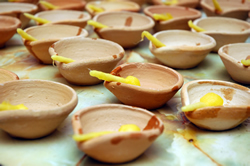Butter was probably first created accidentally when whole milk carried in skin bags was carried by horseback and naturally "churned" while traveling over rough terrain. The first documented mention of butter making was in the sacred songs of the dwellers of Asiatic India, dating back to 1,500-2,000 B.C.E. There is historical mention of ancient tribes creating primitive churns by horizontally agitating cow, yak and horse milk. Butter back then was not only eaten, but used as an illumination oil, for medicinal purposes and also as skin coating to insulate the tribe members from the harsh winter cold.
The expansion of the northern Asian tribes by conquest and colonization brought butter to the inhabitants of southern Asia. However, butter in the southern climates could not be stored as easily as it could in the frozen northern plains. The southerners were the first to clarify butter in order to keep the fat from spoiling.
The Hunza tribe, who live in the remote Himalayan range between Pakistan, India, and China, are famed for their lifespans of 115 or more. Their vitality has been attributed to a culture-rich diet of butter, kefir and yogurt, along with plenty of whole grains. In Hindu culture, the cow is sacred, and butter is the only animal fat that Hindus will eat. The cow represents the soul, with its obstinate intellect, and unruly emotions, but it is also gentle and generous. The butter it gives is a sacred offering, fuel for lamps, and treasured food.
The golden liquid quickly gained popularity in the Middle East and was even elevated to a sacred oil in India. In other southern civilizations, butter was associated with the northern barbarians. It's use was frowned upon in the city states of Ethiopia, Greece and Rome.
In India, clarified butter is called ghee. [Read more about making ghee.] It is the most precious substance provided by the most sacred beast on earth, the cow. In Hindu mythology, Prajápati, Lord of Creatures, created ghee by rubbing or "churning" his hands together and then poured it into fire to engender his progeny; whenever the Vedic ritual was performed of pouring ghee into fire, it was a re‑enactment of creation. (Butter in mythologies the world over is a symbol of semen: churning represents the sexual act, and also the formation of a child in its mother's womb.)
Later, during the Deluge, continues the Indian myth, the honey-like elixir of immortality called amrita got lost in the cosmic ocean of milk. The gods and the demons joined forces to save it by churning the ocean until various gods and sacred objects solidified out like butter from the milk: the cow of plenty, the goddess of wine, the moon, the terrible poison which is twin-liquor to amrita, the coral tree which perfumes the world, the goddess of beauty holding a lotus; finally the physician of the gods stepped carefully forward, carrying a milk-white bowl full of amrita.
One of the hymns of the Rg Veda (circa 1500 BC) is in praise of ghee, and is intended to be accompanied by ritual libations of the golden substance into fire. These are some of the words:
This is the secret name of Butter:
"Tongue of the gods," "navel of immortality."
We will proclaim the name of Butter;
We will sustain it in this sacrifice by bowing low.
These waves of Butter flow like gazelles before the hunter...
Streams of Butter caress the burning wood.
Agni, the fire, loves them and is satisfied.
Here butter is fertilizing seed, a regenerator of riches: its sputtering and crackling reawaken Agni himself. It also represents the pure energy of communal prayer and the inspiration to mysticism and poetry.
Statues of Vishnu and Krishna are ritually anointed with two intensely sacred mixtures of five substances, one called pançamrita: milk, curds, ghee, honey, and sugar, and the other "the five products of the cow": milk, curds, ghee, urine, and dung. Both of these can be used to purify people who have committed temporarily polluting offenses, or as antidotes to poison and disease. The lamps that light the holiest places in Hindu temples are wicks burning in ghee -- as are the lamps swung in circular motions before the images of various deities, or lit at the great Festival of Lights in honor of Lakshmi and Rama.
Hindus rank food (high to low) as raw, superior cooked, inferior cooked, and garbage. No one may eat "inferior" foods, like rice and lentils, which have been touched by someone of a lower caste than himself; but anything "superior" may be taken from any caste except the lowest of all. Inferior food cooked in irreproachable ghee instantly becomes pakka, "complete" or "superior," and edible even by a Brahmin. A traveling Brahmin who does not know who has been touching the food available to him, must receive everything he cats raw and still unpeeled, unless food vendors can demonstrate that their wares are cooked in ghee.
Ghee is expensive and much in demand, because of its exalted status, at Hindu weddings. Male guests are expected to compete with each other to sec who can eat the most of it: consuming a kilo or more at a sitting is considered a proof of virility. The occasion and the sexual connotations of ghee turn the contest into a kind of fertility ritual.
Read more about making ghee.
Help grow this exhibit with your photos! WebExhibits helps connect people and cultures, and you can join in by sending photos of butter from your part of the world. Read more about sharing your photos.


